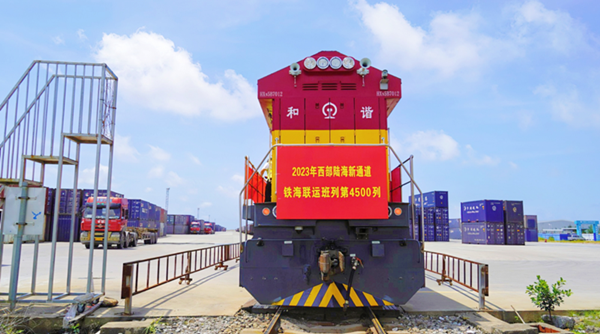
Trade corridor operates 4,500 trains in 1st half of year
In the first six months, 4,500 trains were operated on the New International Land-Sea Trade Corridor in Western China, up 9 percent year-on-year.
The trade corridor is a trade and logistics passage, with an operational hub centered in the municipality of Chongqing in Southwestern China. It serves as a bridge between Western China and ASEAN countries.
The Guangxi Beibu Gulf Port acts as the intersection of the trade corridor's land-sea connectivity.

The 4,500th train in the trade corridor operates in Qinzhou. [Photo/WeChat account: zmqqzgpq]
At present, the radiation range of the trade corridor has expanded to 118 stations in 17 provinces and 61 cities.
Since this year, the Guangxi Beibu Gulf Port Group has held promotion meetings for the trade corridor in Chongqing city and Xi'an in Shaanxi province. It has also deepened cooperation with provinces along the corridor, including Sichuan and Guizhou provinces.
During the same period, Beibu Gulf Port's sea-rail combined trains have completed transportation tasks involving over 700 twenty-foot equivalent units (TEUs) of containers in a single trip four times.
The efficiency of container transportation for the sea-rail combined trains at Beibu Gulf Port has reached 845 TEUs per trip, an increase of 15 percent compared with the previous year. What's more, the peak daily loading volume has reached 834 trains per day, a 26 percent increase compared with the previous year.
In addition, in April, the Kuantan Port-Beibu Gulf Port-Chongqing-Chengdu multimodal transport route opened, promoting trade and commerce between China and ASEAN countries.




